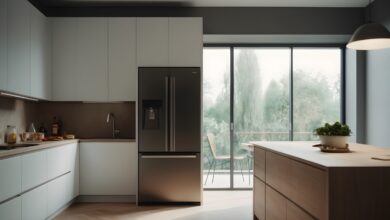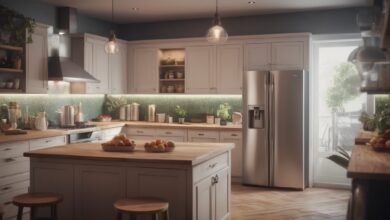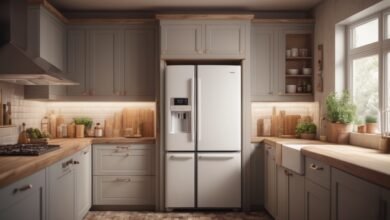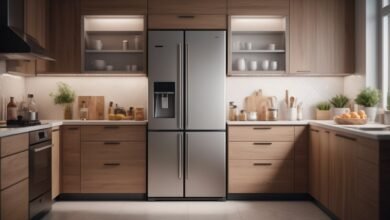Determining the Best Fit for Your Kitchen-Complete Guide

Choosing the perfect refrigerator for your kitchen involves more than just selecting a model that fits your aesthetic preferences. It requires a careful consideration of various factors, from available space and layout to the specific needs of your household. In this detailed blog, we’ll explore the intricacies of determining the best fit for a refrigerator in your kitchen. From measuring and layout considerations to style and functionality, we’ll guide you through the decision-making process to ensure your refrigerator seamlessly integrates into your culinary space.
The Significance of a Thoughtful Selection
The refrigerator is a central appliance in any kitchen, influencing both the organization of groceries and the overall flow of daily life. A well-chosen refrigerator not only enhances functionality but also contributes to the visual appeal of the kitchen. Let’s dive into the key aspects to consider when determining the best fit for a refrigerator in your kitchen.
Understanding Your Kitchen Layout
1. Assess Kitchen Dimensions
Begin by measuring the dimensions of your kitchen, including the width, height, and depth of the space designated for the refrigerator. Consider any constraints, such as the presence of cabinets, countertops, or adjacent walls, that might impact the size of the refrigerator that can comfortably fit.
2. Check Door Clearance
Ensure there is enough door clearance for the refrigerator to be brought into your kitchen without any issues. Measure doorways, hallways, and stairwells to guarantee that the refrigerator can be delivered and installed without complications.
3. Evaluate Available Space
Take stock of the available space where the refrigerator will be placed. Consider the layout of your kitchen and identify potential locations for the refrigerator, ensuring it doesn’t obstruct pathways or impede the functionality of other appliances.
Measuring for Fit
4. Width, Height, and Depth Measurements
Accurate measurements are critical when determining the best fit for your refrigerator. Measure the width, height, and depth of the designated area, accounting for any additional space required for ventilation. Ensure the refrigerator’s dimensions align with the available space in your kitchen.
5. Ventilation Clearance
Refrigerators require adequate ventilation space to operate efficiently. Leave some clearance on the sides, back, and top to ensure proper airflow. This not only helps with energy efficiency but also prevents the refrigerator from overheating.
6. Check for Levelling Adjustments
Check if the floor in the designated area is level. Some refrigerators come with adjustable legs or wheels to accommodate uneven floors. Ensuring a level base is essential for the proper functioning of the refrigerator.
Types of Refrigerators and Styles
7. Top-Freezer Refrigerators
Top-freezer refrigerators are the traditional style with the freezer compartment located at the top. They are often more compact, making them suitable for smaller kitchens. Consider this style if you prioritize freezer space and have height restrictions.
8. Bottom-Freezer Refrigerators
Bottom-freezer refrigerators feature the freezer compartment at the bottom, typically as a pull-out drawer. They offer easy access to fresh foods at eye level, making them suitable for those who prioritize fresh food storage.
9. Side-by-Side Refrigerators
Side-by-side refrigerators have vertical divisions between the fresh food and freezer sections. This style is well-suited for kitchens with narrow spaces, providing easy access to both compartments. However, the narrower design may limit storage for wider items.
10. French Door Refrigerators
French door refrigerators combine a bottom freezer with side-by-side refrigerator doors on top. This style is popular for its spacious and flexible interior, making it an excellent choice for larger households or those who love to entertain.
11. Counter-Depth Refrigerators
Counter-depth refrigerators are designed to align with the depth of standard kitchen countertops. They provide a sleek and integrated look but may offer slightly less storage space compared to standard-depth models.
12. Built-In Refrigerators
Built-in refrigerators are custom-designed to seamlessly blend with kitchen cabinetry. They often feature panels that match the surrounding cabinets, providing a cohesive and upscale appearance. Built-in models are pricier but offer a high-end aesthetic.
Storage Capacity and Family Needs
13. Evaluate Your Household Size
Consider the number of people in your household when determining storage capacity. Larger families may require refrigerators with more storage space to accommodate groceries for multiple meals.
14. Assess Cooking Habits
Assess your cooking habits to determine the appropriate storage capacity. If you cook frequently, you’ll likely need a refrigerator with ample space for fresh ingredients, leftovers, and meal prep items.
15. Freezer Requirements
Evaluate your freezer requirements. If you frequently buy frozen foods or batch-cook and freeze meals, a larger freezer capacity is essential. Some refrigerators offer additional freezer drawers or compartments for better organization.
Energy Efficiency and Budget Considerations
16. Look for Energy Star Certification
Energy Star-certified refrigerators meet strict energy efficiency guidelines. Choosing an Energy Star-rated refrigerator not only reduces your utility bills but also minimizes environmental impact.
17. Set a Realistic Budget
Determine your budget for a new refrigerator. While larger and feature-rich models may be enticing, it’s essential to align your budget with your actual needs. Consider long-term savings in energy costs when investing in an energy-efficient model.
18. Explore Financing Options
Some retailers offer financing options for appliances. If a refrigerator with all the features you desire is slightly above your budget, explore financing plans that allow you to make manageable monthly payments.
Lifestyle and Convenience Features
19. Consider Ice and Water Dispensers
Refrigerators with built-in ice and water dispensers add convenience but may impact the overall size and cost. Consider whether these features align with your preferences and daily routine.
20. Explore Smart Refrigerator Features
Explore smart refrigerator features, such as touchscreen displays, Wi-Fi connectivity, and app integration. While these features may enhance convenience, it’s essential to weigh their importance against the potential increase in cost.
21. Door-in-Door Design
Some refrigerators come with a door-in-door design that allows you to access frequently used items without fully opening the door. While convenient, this feature may impact the overall storage capacity.
Design and Aesthetics
22. Consider Aesthetic Preferences
Consider your aesthetic preferences and the overall design of your kitchen. Choose a refrigerator style and finish that complements the existing decor. Popular finishes include stainless steel, black stainless, and custom paneling for built-in models.
23. Check Hinge Configuration
Determine the hinge configuration that works best for your kitchen layout. Some refrigerators come with reversible doors, allowing you to adjust the hinge direction to suit the design of your space.
24. Evaluate Interior Lighting
Interior lighting contributes to both functionality and aesthetics. Opt for refrigerators with bright and energy-efficient LED lighting. Some models even offer customizable lighting options for a personalized touch.
Future-Proofing Your Investment
25. Anticipate Future Changes
Consider any upcoming changes in your household, such as the addition of family members or changes in lifestyle. Opting for a slightly larger refrigerator than your current needs may account for future growth.
26. Evaluate Resale Value
If you anticipate moving or upgrading your
appliances in the future, consider the resale value of the refrigerator. Popular brands and models with desirable features may retain their value better over time.
27. Flexible Storage Solutions
Choose a refrigerator with flexible storage options that can adapt to changing needs. Features like adjustable shelves, removable bins, and convertible compartments provide versatility for varying storage requirements.
Conclusion
Determining the best fit for a refrigerator in your kitchen requires a thoughtful examination of your kitchen layout, lifestyle, and specific needs. By considering factors such as available space, measurement constraints, storage capacity, energy efficiency, design preferences, and additional features, you can make an informed decision that seamlessly integrates the refrigerator into your daily life. Take the time to research and explore various options, and you’ll be rewarded with a refrigerator that not only meets your functional requirements but also enhances the overall aesthetics of your kitchen. Happy refrigerator shopping!






